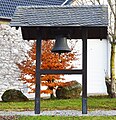Radlinghausen
|
Radlinghausen
City of Brilon
|
|
|---|---|
| Coordinates: 51 ° 25 ′ 53 ″ N , 8 ° 40 ′ 16 ″ E | |
| Height : | 475 m above sea level NN |
| Area : | 2.88 km² |
| Residents : | 130 (Dec. 31, 2019) |
| Population density : | 45 inhabitants / km² |
| Incorporation : | 1st January 1975 |
| Postal code : | 59929 |
| Area code : | 02964 |
|
Location of the village of Radlinghausen within the urban area of Brilon
|
|
|
Center with village pond
|
|
Radlinghausen is a village in the eastern Sauerland in North Rhine-Westphalia . The municipality, which was independent until the end of 1974, now has 130 inhabitants (as of December 31, 2019) and is the third smallest village in the city of Brilon after Esshoff and Rixen . The village is dominated by agriculture.
geography
Radlinghausen is located about eight kilometers northeast of Brilon in the Brilon Heights . Neighboring towns of Radlinghausen are Thülen , Madfeld , Nehden and Rösenbeck . The Almerfeld house is located north of the village .
history
Radlinghausen was first mentioned in 1306 as Ratynchusen. At that time, the Radlinghausen estate was sold by Volpert Baecken and his wife Margarethe to the Verspersslegelle and to the Scharfenberg family. Engelbert van Brilon and the Mayor of Rüthen Rodenberch were the guarantors.
Radlinghausen is the only remaining wagon village in North Rhine-Westphalia . In 1493 the Bredelar monastery acquired the manorial power , which it held until 1803. Radlinghausen belonged to the 19th century to the municipal reorganization in North Rhine-Westphalia for office Thülen .
Towards the end of the Second World War , evacuees due to air raids were also housed in the village of Radlinghausen. In March 1945 some men from the Volkssturm arrived in the village. On March 28th, scattered soldiers of the Wehrmacht reached the village with trucks to quarter themselves. On March 29, a marching group from the Brilon military training camp reached the village. These young people should march towards the northeast to form a "defense" there. A little later, US tanks from the direction of Haus Almerfeld reached the village. The German soldiers fled or hid. A US soldier blew up a cash register and threw its contents on the street. The villagers looted the cash register and the German military trucks. For one night, villagers had to clear some houses for US troops. US patrols later combed the village.
In the Second World War, seven Radlinghausen soldiers died, mostly on the Eastern Front .
Since January 1, 1975 the village has been part of the city of Brilon.
politics
coat of arms

|
Blazon : A golden eight-spoke wheel in blue. Description: It is a talking coat of arms in which the wheel alludes to the name of the community. The colors are freely chosen. Official approval took place on June 4, 1954. |
Culture and sights
The Radlinghauser Chapel of the Holy Trinity was made from limestone rubble by the villagers from 1947 to 1949 . Radlinghausen is part of the Thülen Pastoral Association.
There is a pond in the center of the village. The village is constructed as a double circular. Quartz crystals have been found near the village .
Wind farm
To the east of Radlinghausen, a wind farm has now been built with 39 wind turbines (28 from Enercon , six from Tacke , two from Südwind , two from Fuhrländer and one from DeWind ). At the beginning of 2011, four old wind turbines from Nordex were replaced by a 179 m high E-82 system from Enercon . In 2017 the wind farm was expanded by eight more E-82 turbines.
Overview of the systems installed in the wind farm
| company | Type | number | Construction year | Total height (in m) |
Power (in kW) |
|---|---|---|---|---|---|
| DeWind | D6 | 1 | 2002 | 107.5 | 1250 |
| Enercon | E-48 | 1 | 2006 | 100 | 800 |
| E-66 | 12 | 2004 | 131 | 1500 | |
| E-82 | 6th | 2006 | 139 | 2000 | |
| E-82 E2 | 1 | 2010 | 179 | 2300 | |
| 8th | 2017 | ||||
| Fuhrländer | FL 70 | 2 | 2005 | 138.5 | 1500 |
| South wind | S46 | 2 | 1999 | 97 | 600 |
| Tackle | 1.5s | 6th | 1999 | 99.95 | 1500 |
| total | 39 |
65950 (65,950 MW) |
Views
literature
- Hugo Cramer: The district of Brilon in the Second World War 1939–1945 - reports from many employees from all over the district. Josefs-Druckerei, Bigge 1955.
Individual evidence
- ↑ Population statistics of the city of Brilon accessed on April 24, 2020.
- ^ Alfred Bruns: Inventory of the Brilon City Archives, Stock A, 1970. Edited by the State Office for Archive Maintenance, Verlag Aschendorff, Münster, pp. 14, 15.
- ^ A b Eduard Belke, Alfred Bruns, Helmut Müller: Municipal coat of arms of the Duchy of Westphalia, Kurkölnisches Sauerland . Ed .: Sauerländer Heimatbund e. V. Strobel, Arnsberg 1986, ISBN 3-87793-017-4 , p. 178 .
- ^ Hugo Cramer: The district of Brilon in the Second World War 1939-1945 . 1955, Radlinghausen section, pp. 52-53.
- ^ Hugo Cramer: The district of Brilon in the Second World War 1939-1945 . 1955, honor roll section Radlinghausen, p. 243.
- ^ Federal Statistical Office (ed.): Historical municipality directory for the Federal Republic of Germany. Name, border and key number changes in municipalities, counties and administrative districts from May 27, 1970 to December 31, 1982 . W. Kohlhammer, Stuttgart / Mainz 1983, ISBN 3-17-003263-1 , p. 332 .
- ↑ http://www.windfang.de/projekt.htm








